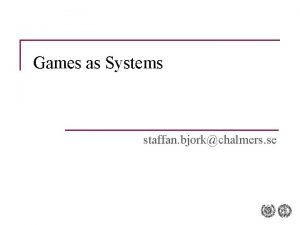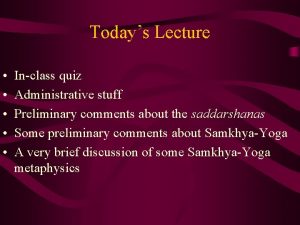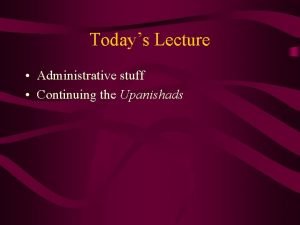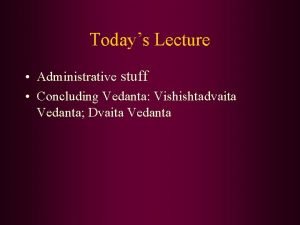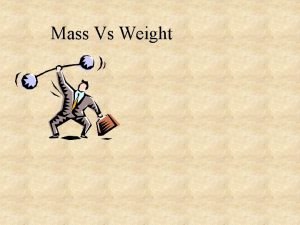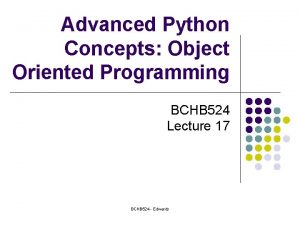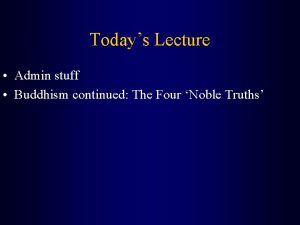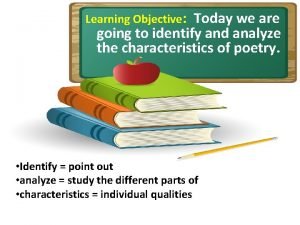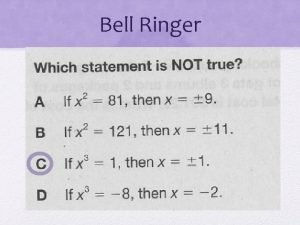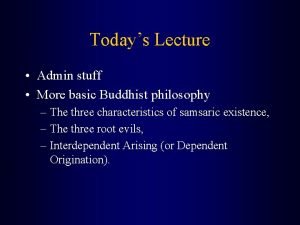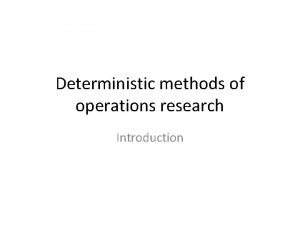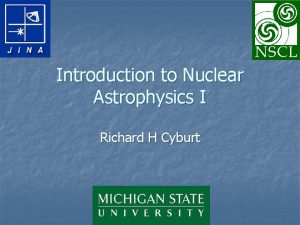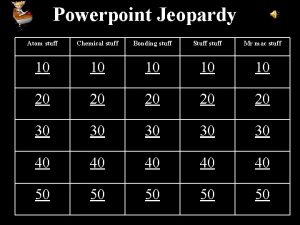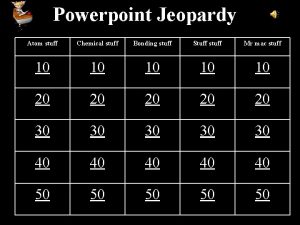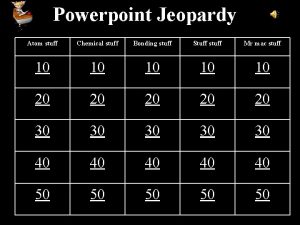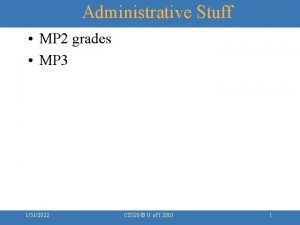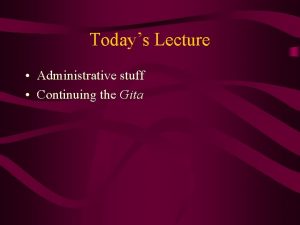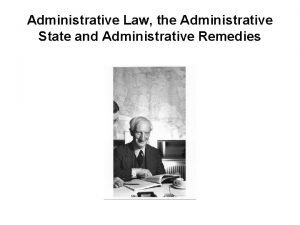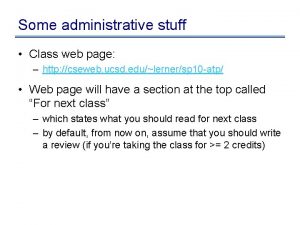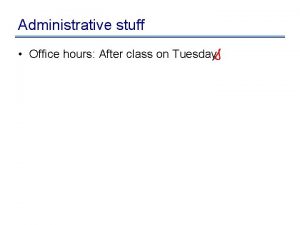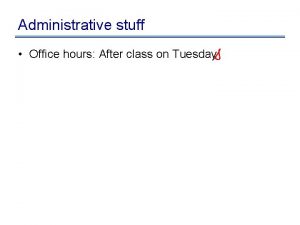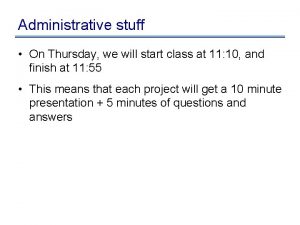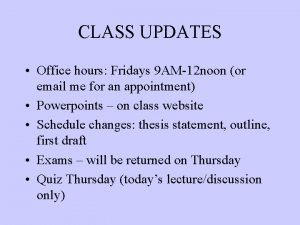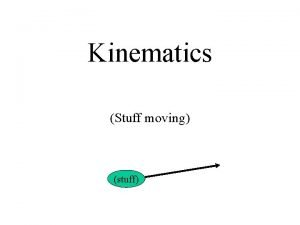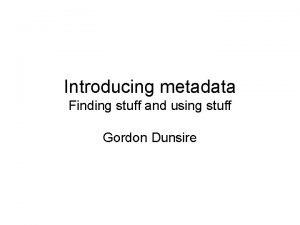Administrative Stuff MP 1 grades Fridays class in





























- Slides: 29

Administrative Stuff • MP 1 grades • Friday’s class in 2, Education Building. 1/23/2022 CS 320 © U of I 2001 1

CS 320/ECE 392/CSE 302 Data Parallel Architectures & Message Passing Architectures Department of Computer Science University of Illinois at Urbana-Champaign 1/23/2022 CS 320 © U of I 2001 2

Contents • Brief overview of Data Parallel Architectures. • Overview of Message Passing Architectures. • Message Passing Programming Model 1/23/2022 CS 320 © U of I 2001 3

References • Parallel Computer Architecture, Culler, Singh & Gupta, Chapter 1 • Highly Parallel Computing, Almasi & Gottlieb, Chapter 4 • In Search of Clusters, Pfister. 1/23/2022 CS 320 © U of I 2001 4

Data Parallel Programming • Programming model – Operations performed in parallel on each element of data structure – Logically single thread of control, performs sequential or parallel steps – Conceptually, a processor associated with each data element 1/23/2022 CS 320 © U of I 2001 5

Data Parallel Systems • Architectural model – Array of many simple, cheap processors with little memory each • Processors don’t sequence through instructions – Attached to a control processor that issues instructions – Specialized and general communication, cheap global synchronization 1/23/2022 CS 320 © U of I 2001 6

Data Parallel Systems Original motivations • Matches simple differential equation solvers • Centralize high cost of instruction fetch/sequencing 1/23/2022 CS 320 © U of I 2001 7

Application of Data Parallelism – Each PE contains an employee record with his/her salary If salary > 100 K then salary = salary *1. 05 else salary = salary *1. 10 – Logically, the whole operation is a single step – Some processors enabled for arithmetic operation, others disabled 1/23/2022 CS 320 © U of I 2001 8

Application of Data Parallelism • Other examples: – Finite differences, linear algebra, . . . – Document searching, graphics, image processing, . . . • Some recent machines: – Thinking Machines CM-1, CM-2 (and CM-5) – Maspar MP-1 and MP-2 1/23/2022 CS 320 © U of I 2001 9

Example: CM 2 • The CM-2 Connection Machine from Thinking Machines Corporation was a massively parallel SIMD computing system consisting of 64 K, 32 K, or 16 K data processors (K = 1024). • Each data processor has 64 Kbits (8 Kbytes) of bit-addressable local memory, a bit-serial ALU that can operate on variable length operands, four 1 -bit flag registers, a router interface, a NEWS grid interface, and an I/O interface. 1/23/2022 CS 320 © U of I 2001 10

Example: CM 2 • Each data processor can access memory at the rate of 5 Mbits/s. A fully configured CM-2 thus has 512 Mbytes of memory that can be read or written at the rate of 300 Gbits/s. • When 64 K data processors are operating in parallel, each performing a 32 -bit addition, the CM-2 parallel processing unit operates at about 2500 MIPS. 1/23/2022 CS 320 © U of I 2001 11

Example: CM 2 • In addition to the standard ALU, the CM-2 unit allows for optional floating point accelerator chips that are shared among every group of 32 data processors • Aggregate peak floating point performance of the CM-2 is 3500 MFLOPS. • The CM-2 system was designed to operate under the programmed control of a front end computer which maybe a SUN/4 workstation, a Symbolics 3600 LISP machine, or a DEC VAX 8000 series computer. 1/23/2022 CS 320 © U of I 2001 12

Example: CM 2 • The front end machines provide the program development and execution environment. • All Connection Machine programs execute in the front end; during the course of the execution the front end issues instructions to the CM-2 parallel processing unit. 1/23/2022 CS 320 © U of I 2001 13

Evolution and Convergence • Rigid control structure (SIMD in Flynn taxonomy) • Popular when cost savings of centralized sequencer high – 60 s when CPU was a cabinet – Replaced by vectors in mid-70 s • More flexible w. r. t. memory layout and easier to manage – Revived in mid-80 s when 32 -bit datapath slices just fit on chip – No longer true with modern microprocessors 1/23/2022 CS 320 © U of I 2001 14

Evolution and Convergence • Other reasons for demise – Simple, regular applications have good locality, can do well anyway – Loss of applicability due to hardwiring data parallelism • MIMD machines as effective for data parallelism and more general 1/23/2022 CS 320 © U of I 2001 15

Evolution and Convergence • Prog. model converges with SPMD (single program multiple data) – Contributes need for fast global synchronization – Structured global address space, implemented with either SAS or MP 1/23/2022 CS 320 © U of I 2001 16

Message Passing Architectures • Complete computer as building block, including I/O – Communication via explicit I/O operations • Programming model: directly access only private address space (local memory), comm. via explicit messages (send/receive) 1/23/2022 CS 320 © U of I 2001 17

Message Passing Architectures • High-level block diagram similar to distributed-memory SAS – But comm. integrated at IO level, needn’t be into memory system – Like networks of workstations (clusters), but tighter integration – Easier to build than scalable SAS • Programming model more removed from basic hardware operations – Library or OS intervention 1/23/2022 CS 320 © U of I 2001 18

Message-Passing Abstraction Match Receive. Y, P, t Address. Y Send. X, Q, t Address. X Local process address space Process P Process Q – Send specifies buffer to be transmitted and receiving process – Recv specifies sending process and application storage to receive into 1/23/2022 CS 320 © U of I 2001 19

Message-Passing Abstraction – Memory to memory copy, but need to name processes – Optional tag on send and matching rule on receive – User process names local data and entities in process/tag space too – In simplest form, the send/recv match achieves pairwise synch event • Other variants too – Many overheads: copying, buffer management, protection 1/23/2022 CS 320 © U of I 2001 20

Evolution of Message-Passing Machines • Early machines: FIFO on each link – Hw close to prog. Model; synchronous ops – Replaced by DMA, enabling non-blocking ops • Buffered by system at destination until recv 1/23/2022 CS 320 © U of I 2001 21

Evolution of Message-Passing Machines • Diminishing role of topology – Store&forward routing: topology important – Introduction of pipelined routing made it less so – Cost is in node-network interface – Simplifies programming 1/23/2022 CS 320 © U of I 2001 22

Example: IBM SP-2 1/23/2022 CS 320 © U of I 2001 23

Example: IBM SP-2 – Made out of essentially complete RS 6000 workstations – Network interface integrated in I/O bus (bw limited by I/O bus) 1/23/2022 CS 320 © U of I 2001 24

Example Intel Paragon 1/23/2022 CS 320 © U of I 2001 25

Message Passing Programming Model • Naming: Processes can name private data directly. – No shared address space • Operations: Explicit communication through send and receive – Send transfers data from private address space to another process – Receive copies data from process to private address space – Must be able to name processes 1/23/2022 CS 320 © U of I 2001 26

Message Passing Programming Model • Ordering: – Program order within a process – Send and receive can provide pt to pt synch between processes – Mutual exclusion inherent • Can construct global address space: – Process number + address within process address space – But no direct operations on these names 1/23/2022 CS 320 © U of I 2001 27

Summary • Overview of Data Parallel and Message Passing Architectures • Message Passing Programming 1/23/2022 CS 320 © U of I 2001 28

What is Next? • Message Passing Programming • MPI • Read chapters 2, 3 of Using MPI 1/23/2022 CS 320 © U of I 2001 29
 Fridays class
Fridays class Administrative stuff
Administrative stuff Administrative stuff
Administrative stuff Administrative stuff
Administrative stuff Dvaita advaita vishishtadvaita
Dvaita advaita vishishtadvaita East coast fridays
East coast fridays Parroquia 12 apostoles chorrillos
Parroquia 12 apostoles chorrillos Ankylosaurus poem
Ankylosaurus poem Spaghetti spaghetti by jack prelutsky
Spaghetti spaghetti by jack prelutsky Copyright science stuff
Copyright science stuff Weight of stuff
Weight of stuff Stuff
Stuff Side by side stuff
Side by side stuff Admin stuff
Admin stuff Spoken poetry english
Spoken poetry english Spaghetti spaghetti you're wonderful stuff
Spaghetti spaghetti you're wonderful stuff Copyright science stuff
Copyright science stuff Weight of stuff
Weight of stuff Amy brown science
Amy brown science Spaghetti spaghetti you're wonderful stuff
Spaghetti spaghetti you're wonderful stuff Admin stuff
Admin stuff The ride stuff readworks answer key
The ride stuff readworks answer key Cellulare otto
Cellulare otto I say stuff without thinking
I say stuff without thinking Formal stuff
Formal stuff Sagan we are made of star stuff
Sagan we are made of star stuff This is the very painting of your fear
This is the very painting of your fear Admin stuff
Admin stuff Obvious stuff
Obvious stuff Slippery stuff ingredients
Slippery stuff ingredients

